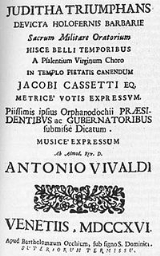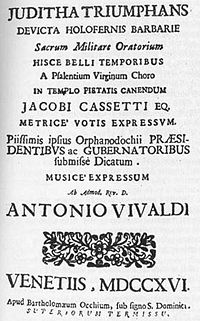
Juditha triumphans
Encyclopedia

Barbarian
Barbarian and savage are terms used to refer to a person who is perceived to be uncivilized. The word is often used either in a general reference to a member of a nation or ethnos, typically a tribal society as seen by an urban civilization either viewed as inferior, or admired as a noble savage...
s of Holofernes
Holofernes
In the deuterocanonical Book of Judith Holofernes was an invading general of Nebuchadnezzar. Nebuchadnezzar dispatched Holofernes to take vengeance on the nations of the west that had withheld their assistance to his reign...
, Vivaldi catalogue number RV 644, is an oratorio
Oratorio
An oratorio is a large musical composition including an orchestra, a choir, and soloists. Like an opera, an oratorio includes the use of a choir, soloists, an ensemble, various distinguishable characters, and arias...
by Antonio Vivaldi
Antonio Vivaldi
Antonio Lucio Vivaldi , nicknamed because of his red hair, was an Italian Baroque composer, priest, and virtuoso violinist, born in Venice. Vivaldi is recognized as one of the greatest Baroque composers, and his influence during his lifetime was widespread over Europe...
, the only survivor of the four that he is known to have composed. The libretto
Libretto
A libretto is the text used in an extended musical work such as an opera, operetta, masque, oratorio, cantata, or musical. The term "libretto" is also sometimes used to refer to the text of major liturgical works, such as mass, requiem, and sacred cantata, or even the story line of a...
was written by Iacopo Cassetti, based upon the Biblical Book of Judith.
Juditha triumphans was composed and performed in November of 1716 in Venice
Venice
Venice is a city in northern Italy which is renowned for the beauty of its setting, its architecture and its artworks. It is the capital of the Veneto region...
by the orchestra and choir of the Ospedale della Pietà
Ospedale della Pietà
The Ospedale della Pietà was a convent, orphanage, and music school in Venice.Like other Venetian ospedali, the Pietà was established as a hostel for Crusaders...
and is described as his first great oratorio.
The work was commissioned to celebrate the victory of the Republic of Venice
Republic of Venice
The Republic of Venice or Venetian Republic was a state originating from the city of Venice in Northeastern Italy. It existed for over a millennium, from the late 7th century until 1797. It was formally known as the Most Serene Republic of Venice and is often referred to as La Serenissima, in...
over the Turks during the siege of Corfu.
In July 1716, the Turks had landed on Corfu and set siege to the island.
The population resisted the occupation and in August, Venice signed an alliance with the Holy Roman Emperor
Holy Roman Empire
The Holy Roman Empire was a realm that existed from 962 to 1806 in Central Europe.It was ruled by the Holy Roman Emperor. Its character changed during the Middle Ages and the Early Modern period, when the power of the emperor gradually weakened in favour of the princes...
.
On 18 August, under the leadership of count Johann Matthias von der Schulenburg
Johann Matthias von der Schulenburg
Reichsfreiherr and Reichsgraf Marshal Johann Matthias von der Schulenburg was a distinguished aristocrat and general of Brandenburg-Prussian descent who served in the Saxon and Venetian armies in the early eighteenth century and found a second career in retirement in Venice, as a grand...
, the decisive battle was won and the Turks abandoned the island.
Juditha Triumphans was represented at the Pietà in November and was a great success.
The story of Judith and her victory on the invading Holofernes
Holofernes
In the deuterocanonical Book of Judith Holofernes was an invading general of Nebuchadnezzar. Nebuchadnezzar dispatched Holofernes to take vengeance on the nations of the west that had withheld their assistance to his reign...
was an allegory of Venice defeating the invading Turks in Corfu
Corfu
Corfu is a Greek island in the Ionian Sea. It is the second largest of the Ionian Islands, and, including its small satellite islands, forms the edge of the northwestern frontier of Greece. The island is part of the Corfu regional unit, and is administered as a single municipality. The...
.
The victorious General von der Schulenburg was among the audience.
Score
All characters, male and female, were interpreted by the girls of the Ospedale.They are:
- Juditha, contraltoContraltoContralto is the deepest female classical singing voice, with the lowest tessitura, falling between tenor and mezzo-soprano. It typically ranges between the F below middle C to the second G above middle C , although at the extremes some voices can reach the E below middle C or the second B above...
, a young Bethulian widow. - Vagaus, sopranoSopranoA soprano is a voice type with a vocal range from approximately middle C to "high A" in choral music, or to "soprano C" or higher in operatic music. In four-part chorale style harmony, the soprano takes the highest part, which usually encompasses the melody...
, eunuch, Holofernes's squire. - Holofernes, contraltoContraltoContralto is the deepest female classical singing voice, with the lowest tessitura, falling between tenor and mezzo-soprano. It typically ranges between the F below middle C to the second G above middle C , although at the extremes some voices can reach the E below middle C or the second B above...
, Assyrian general. - Abra, sopranoSopranoA soprano is a voice type with a vocal range from approximately middle C to "high A" in choral music, or to "soprano C" or higher in operatic music. In four-part chorale style harmony, the soprano takes the highest part, which usually encompasses the melody...
, Juditha's handmaid. - Ozias, contraltoContraltoContralto is the deepest female classical singing voice, with the lowest tessitura, falling between tenor and mezzo-soprano. It typically ranges between the F below middle C to the second G above middle C , although at the extremes some voices can reach the E below middle C or the second B above...
, high priest of Bethulia.
An all-female choir sings the parts of the Assyria
Assyria
Assyria was a Semitic Akkadian kingdom, extant as a nation state from the mid–23rd century BC to 608 BC centred on the Upper Tigris river, in northern Mesopotamia , that came to rule regional empires a number of times through history. It was named for its original capital, the ancient city of Assur...
n soldiers and of the Bethulia
Bethulia
Bethulia Bethulia Bethulia (Hebrew: בתוליה; in Greek Betuloua, is a Biblical city whose deliverance by Judith, when besieged by Holofernes, forms the subject of the Book of Judith....
n women.
The string orchestra
String orchestra
A string orchestra is an orchestra composed solely or primarily of instruments from the string family. These instruments are the violin, the viola, the cello, the double bass , the piano, the harp, and sometimes percussion...
is augmented by timpani
Timpani
Timpani, or kettledrums, are musical instruments in the percussion family. A type of drum, they consist of a skin called a head stretched over a large bowl traditionally made of copper. They are played by striking the head with a specialized drum stick called a timpani stick or timpani mallet...
, 2 trumpet
Trumpet
The trumpet is the musical instrument with the highest register in the brass family. Trumpets are among the oldest musical instruments, dating back to at least 1500 BCE. They are played by blowing air through closed lips, producing a "buzzing" sound which starts a standing wave vibration in the air...
s, mandolin
Mandolin
A mandolin is a musical instrument in the lute family . It descends from the mandore, a soprano member of the lute family. The mandolin soundboard comes in many shapes—but generally round or teardrop-shaped, sometimes with scrolls or other projections. A mandolin may have f-holes, or a single...
, 4 theorbo
Theorbo
A theorbo is a plucked string instrument. As a name, theorbo signifies a number of long-necked lutes with second pegboxes, such as the liuto attiorbato, the French théorbe des pièces, the English theorbo, the archlute, the German baroque lute, the angélique or angelica. The etymology of the name...
s, 5 violas all'inglese (viola da gamba), 1 viola d'amore
Viola d'amore
The viola d'amore is a 7- or 6-stringed musical instrument with sympathetic strings used chiefly in the baroque period. It is played under the chin in the same manner as the violin.- Structure and sound :...
, 2 recorders, 2 soprano chalumeau
Chalumeau
This article is about the historical musical instrument. For the register on the clarinet that is named for this instrument, see Clarinet#Range....
x, 2 oboe
Oboe
The oboe is a double reed musical instrument of the woodwind family. In English, prior to 1770, the instrument was called "hautbois" , "hoboy", or "French hoboy". The spelling "oboe" was adopted into English ca...
s, organ
Pipe organ
The pipe organ is a musical instrument that produces sound by driving pressurized air through pipes selected via a keyboard. Because each organ pipe produces a single pitch, the pipes are provided in sets called ranks, each of which has a common timbre and volume throughout the keyboard compass...
.
Plot
The Assyrian king Nebuchadrezzar sends an army against Israel to demand overdue tributes.Under the leadership of the general Holofernes, the Assyrians lay siege to the town of Bethulia and are about to conquer it.
The young Jewish widow Judith goes to him to implore mercy.
He falls in love with her and she indulges him.
After a rich banquet and having drunk much wine, Holofernes falls asleep.
Judith beheads him, flees the enemy camp, and returns victorious to Bethulia.

